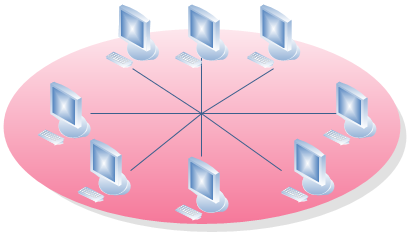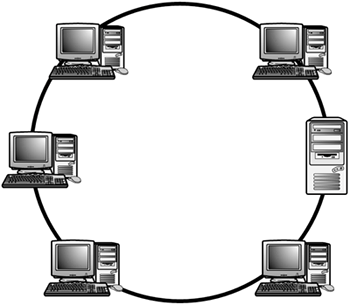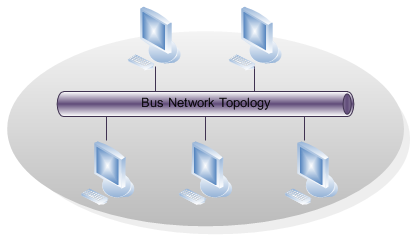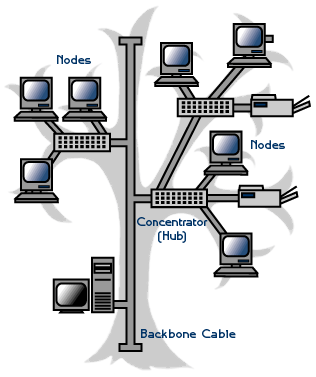Network Topologies
NETWORKING TOPOLOGIES
THERE ARE THREE PRIMARY TYPES OF NETWORK TOPOLOGIES, WHICH REFER TO THE PHYSICAL AND LOGICAL LAYOUT OF THE NETWORK CABLING. THEY ARE BUS, STAR AND RING. BUS AND STAR ARE THE MOST WIDELY USED FOR ETHERNET NETWORKS AND RING IS USED FOR TOKEN RING NETWORKS.
Star Topology
In a star network, each node (computer or other device) is directly connected to the central computer or Hub that provides connection points for nodes on the network. The star topology is the most common topology in use today. In star network, information or data is communicated from one computer to another through Hub. This form of network configuration looks like a star as shown in figure below.
Advantages
The main advantages of star topology are: • It is easy to install and to maintain. • You can easily add and remove nodes to and from the network without affecting the network. • If any node fails, other nodes are not affected.
Disadvantages
The main disadvantages of star topology are: • This type of network depends upon the central Hub. If Hub fails the entire network is failed. • Each computer is directly connected to the Hub through a cable, so it becomes more costly.
Advantages
The main advantages of star topology are: • It is easy to install and to maintain. • You can easily add and remove nodes to and from the network without affecting the network. • If any node fails, other nodes are not affected.
Disadvantages
The main disadvantages of star topology are: • This type of network depends upon the central Hub. If Hub fails the entire network is failed. • Each computer is directly connected to the Hub through a cable, so it becomes more costly.
Ring Topology
In ring network, each node is connected to two adjacent nodes in the form a closed ring or loop. In ring topology, the last node connects to the first node to complete the ring. In ring topology, each node has a dedicated point-to-point connection only with the two devices on either side of it. In this network, data is communicated in one direction from node to node around the entire ring. When a computer in ring network sends message to another computer on the network, the message travels to each node or computer until it reaches its destination. The ring network configuration is shown in figure below.
Advantages
The main advantages of ring topology are: • It is less expensive than star topology. • Nodes can be easily added or removed. Disadvantages The main disadvantages of ring topology are: • It is more difficult to install and maintain. • If a node fails, it affects the entire network.
Bus Topology
In bus network, all nodes are connected to a common communication medium or central cable. The central physical cable that connects the nodes is called Bus. The data is communicated between nodes in both directions through bus. A bus topology uses the multipoint connection. The central single cable (or bus) acts as backbone to link all the devices to the network. In bus network, when a computer sends a message to another computer it also attaches the address of the destination computer. In bus topology, a special device called a terminator is attached at the cable’s start and end points. A terminator stops the network signals. In LAN, bus topology is mostly used. In this topology, each computer is assigned a unique address. The bus network configuration is given in figure image. Advantages The main advantages of bus topology are: • It is less expensive and easy to install and maintain. • When nodes are added and removed to and from the network, the network is not affected. • If one node fails other nodes are not affected.
Disadvantages
The main disadvantages of bus topology are: • It supports only a small number of nodes. • Entire network fails if there is any problem in the central cable.
Tree or Expanded Star
A tree topology combines characteristics of linear bus and star topologies. It consists of groups of star-configured workstations connected to a linear bus backbone cable. Tree topologies allow for the expansion of an existing network, and enable schools to configure a network to meet their needs. Advantages of a Tree Topology • Point-to-point wiring for individual segments. • Supported by several hardware and software venders.
Disadvantages of a Tree Topology
• Overall length of each segment is limited by the type of cabling used. • If the backbone line breaks, the entire segment goes down. • More difficult to configure and wire than other topologies.



